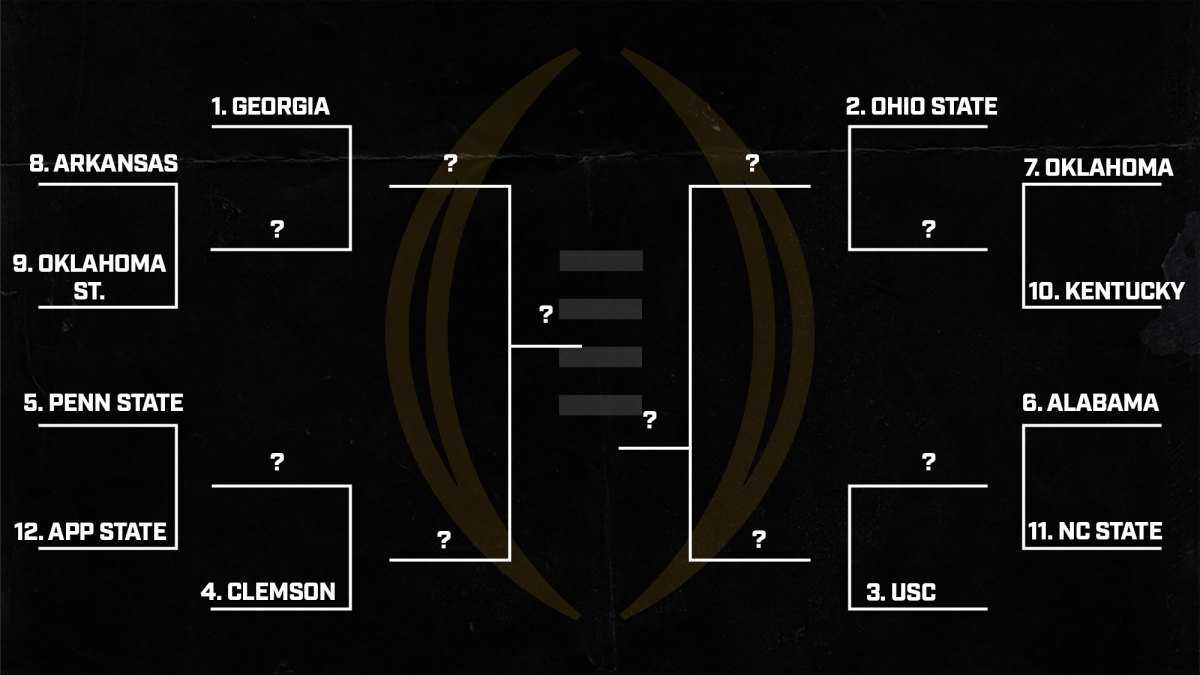App State in the College Football Playoff? Our Mock 12-Team Bracket Says Yes

Why wait a few years before assembling an expanded College Football Playoff bracket when we can do it now?! Let’s celebrate college leaders finally agreeing on something that is good for the entire sport, coast to coast.
Using the current college football standings to create an imaginary 12-team playoff bracket based on the model adopted earlier this month by CFP executives, this 12-team model features (1) automatic qualifiers to the six highest-ranked conference champions and (2) six at-large selections to the next six highest-ranked teams. The four highest-ranked conference champions receive byes to the second round (independents are not eligible to receive a bye). We mostly used the polls for seeding, but put more of an emphasis on a team’s competition up to this point.
If a team has played a bunch of cupcakes (Michigan!), it will be reflected in its seeding.
Now, before fans become outraged, we are just three weeks into the season. We have a small sample size by which to judge teams, as we did not factor in preseason polls or last season’s results. The sample size is small enough that many teams don’t have a single quality win. Others just made the cut based on one game alone—App State (win at Texas A&M), Kentucky (victory at Florida), Oklahoma State (over Arizona State) and Arkansas (beating Cincinnati).
In terms of seedings, the only definite automatic qualifier from the SEC is Georgia, who earns the No. 1 seed. Everything else is debatable, but the 12-team format delivers some fun on-campus first-round games.

- 1. Georgia (SEC champion)
- 2. Ohio State (Big Ten champion)
- 3. USC (Pac-12 champion)
- 4. Clemson (ACC champion)
- 5. Penn State (Big Ten at-large)
- 6. Alabama (SEC at-large)
- 7. Oklahoma (Big 12 champion)
- 8. Arkansas (SEC at-large)
- 9. Oklahoma State (Big 12 at-large)
- 10. Kentucky (SEC at-large)
- 11. NC State (ACC at-large)
- 12. Appalachian State (Sun Belt champion)
A notable absence
If Wolverines fans are raising eyebrows over Michigan’s absence behind teams like Oklahoma State, Kentucky and Arkansas, they should look at the team’s schedule so far—Colorado State, Hawaii and UConn. Those three teams combined for a 10–27 record last season. Michigan is the rare Power 5 team to not yet play against another Power 5 program. That ends this weekend when the Wolverines host 3-0 Maryland.
A trio of tough calls
No matter the size and scope of any postseason bracket, this 12-team model will still end with decisions that make some fan bases happy and others angry. The format will focus around three points of intense discussion: (1) Which team receives the No. 4 seed and final first-round bye; (2) which team receives the No. 8 seed and final home first-round game; and (3) Which team gets the final at-large spot. All three are tough, tight calls, especially between the 4/5 seeds, 8/9 seeds and the final at-large participant/best bubble team. When we’ve got a three-week sample size, the differences are microscopic—Clemson barely nudged Oklahoma for the bye, Arkansas topped Oklahoma State by its quality win against Cincinnati, and NC State squeezed in over teams like Michigan, Tennessee, Ole Miss and … Kansas. Yes, Kansas was in consideration!
The G5 champion
One of the great things about the 12-team model is it will include at least one Group of 5 team cracking the field. The best champion from the Sun Belt, C-USA, Mountain West, MAC or American will find its way into the bracket. In most cases, the G5 champion will be the No. 12 seed, but not always (Cincinnati would have received a first-round bye last season based on the new model). App State’s win against Texas A&M, and its subsequent Hail Mary victory over Troy on Saturday, gave it the nudge over a few other worthy G5 competitors—Tulane (yes, Tulane!), SMU, Coastal Carolina and Cincinnati.
Watch college football live with fuboTV: Start your free trial today!
More College Football Coverage:
